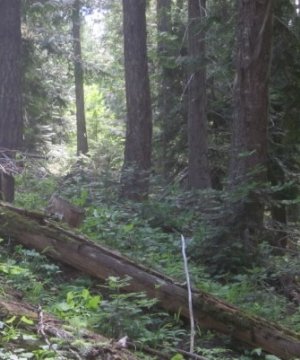
Acidic Grand Fir Mosaic 30-45" PZ Frigid Clearwater Mountains
Scenario model
Current ecosystem state
Select a state
Management practices/drivers
Select a transition or restoration pathway
- Transition T1A More details
- Restoration pathway R2A More details
-
No transition or restoration pathway between the selected states has been described
Target ecosystem state
Select a state
Description
These are climax plant communities that persist within a matrix of overmature grand fir (Abies grandis) and western redcedar (Thuja plicata) forests and tree islands. There are few wildfires, so natural succession has reduced the occurrence of seral conifers such as lodgepole pine (Pinus contorta), Douglas-fir (Pseudotsuga menziesii), western white pine (Pinus monticola), and western larch (Larix occidentalis). Late successional, shade-tolerant species like grand fir, western redcedar, Pacific yew (Taxus brevifolia), and sometimes mountain hemlock (Tsuga mertensiana) and subalpine fir (Abies lasiocarpa), are common along with mid-successional Engelmann spruce (Picea engelmannii). Regeneration of conifers in forest canopy openings is a slow and unreliable process in these low pH volcanic ash-cap soils that have abundant populations of pocket gophers (Thomomys talpoides). Disjunct and rare plant species occur in and near these forests, including evergreen synthyris (Synthyris platycarpa), Oregon bluebell (Mertensia bella), Dasynotus (Dasynotus daubenmirei), and Case’s corydalis (Corydalis caseana). Reoccurring severe fires in the can cause expansion of the glades into formerly forested areas. Fire exclusion for long periods allows the forest composition to move to late successional, shade-tolerant species like grand fir, western redcedar, Pacific yew (Taxus brevifolia), and sometimes mountain hemlock (Tsuga mertensiana) and subalpine fir (Abies lasiocarpa). However, succession does not lead to a reduction in size of glade areas
Submodel
Description
Severe fires or other historic disturbance creates glade openings. Successional plant communities in the GFM are dominated by bracken fern and western coneflower. Bracken fern is usually present in low densities under forest canopies, but rapidly expands following disturbance. Once established these communities are very persistent. They appear to be maintained by a combination of allelopathy, pocket gopher activity and changes in soil minerology and chemistry due to increased organic matter contribution
Submodel
Mechanism
Severe burns kill regeneration and allow for invasion and expansion of glade assemblage species. Presence of bracken fern and other glade species in pre-fire understory provides opportunity for rapid site colonization. Pocket gopher activity increases with proliferation of bracken fern.
Model keys
Briefcase
Add ecological sites and Major Land Resource Areas to your briefcase by clicking on the briefcase (![]() ) icon wherever it occurs. Drag and drop items to reorder. Cookies are used to store briefcase items between browsing sessions. Because of this, the number of items that can be added to your briefcase is limited, and briefcase items added on one device and browser cannot be accessed from another device or browser. Users who do not wish to place cookies on their devices should not use the briefcase tool. Briefcase cookies serve no other purpose than described here and are deleted whenever browsing history is cleared.
) icon wherever it occurs. Drag and drop items to reorder. Cookies are used to store briefcase items between browsing sessions. Because of this, the number of items that can be added to your briefcase is limited, and briefcase items added on one device and browser cannot be accessed from another device or browser. Users who do not wish to place cookies on their devices should not use the briefcase tool. Briefcase cookies serve no other purpose than described here and are deleted whenever browsing history is cleared.
Ecological sites
Major Land Resource Areas
The Ecosystem Dynamics Interpretive Tool is an information system framework developed by the USDA-ARS Jornada Experimental Range, USDA Natural Resources Conservation Service, and New Mexico State University.


